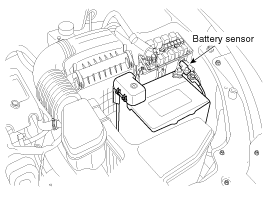Description
Vehicles have many control units that use more electricity. These units
control their own system based on information from diverse sensors. It is important
to have a stable power supply as there diverse sensors giving a variety of information.
Battery sensor is mounted on battery (-) terminal. It transmits battery voltage,
current, temperature information to ECM. ECM controls generating voltage by
duty cycle based on these signals.

|
When battery sensor signal fault occurs, inspect the vehicle parasitic
draw in advance after inspecting the sensor because the sensor will
behave abnormally when the parasitic draw is more than 100mA. (Refer
to vehicle parasitic current inspection)
|
|
Perform the following process after replacing the battery sensor.
| 1. |
Ignition switch ON/OFF.
|
| 2. |
Park the vehicle about 4 hours.
|
| 3. |
After 4 hours later, check the SOC (State of charge) of
battery using GDS.
|
|
|
For the vehicle equipped with a battery sensor, be careful not
to damage the battery sensor when the battery is replaced or recharged.
| 1. |
When replacing the battery, it should be same one (type,
capacity and brand) that is originally installed on your vehicle.
If a battery of a different type is replaced, the battery sensor
may recognize the battery to be abnormal.
|
| 2. |
When installing the ground cable on the negative post
of battery, tighten the clamp with specified torque of 4.0~6.0N.m
(0.4~0.6kgf.m, 3.0~4.4lb-ft). An excessive tightening torque
can damage the PCB internal circuit and the battery terminal.
|
| 3. |
When recharging the battery, ground the negative terminal
of the booster battery to the vehicle body. If the negative
cable from a battery charger is connected to the negative terminal
of the battery, the battery sensor can make an error. In this
case, repeat the above process for battery sensor replacement
(1~3) after disconnecting and reconnecting the battery connector.
|
|
Removal and Installation
1.
Disconnect the terminals from the battery.
Tightening torque :
(+) terminal (A) : 7.8 ~ 9.8N.m (0.8 ~ 1.0kgf. ...
See also:
Cowl Top Cover. Repair procedures
Replacement
1.
Remove the covers and remove the nuts, then remove the wiper arm
(A).
2.
Detach the clips, then remove the cowl top ...
Body Control Module (BCM). Repair procedures
Trouble Diagnostics When Using GDS
1.
The body control module can diagnose by using the GDS more quickly.
The BCM communicates with the GDS and then reads the input ...
Repair procedures
Operation and Leakage Check
Check all of the following items:
Component
Procedure
Brake Booster (A)
Check brake operation by applying the brakes ...
 Hyundai Sonata: Battery Sensor. Description and Operation
Hyundai Sonata: Battery Sensor. Description and Operation
 Battery. Repair procedures
Battery. Repair procedures Starting System
Starting System